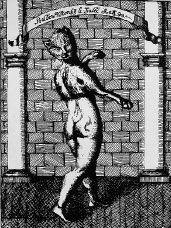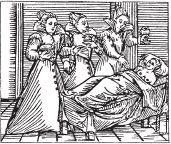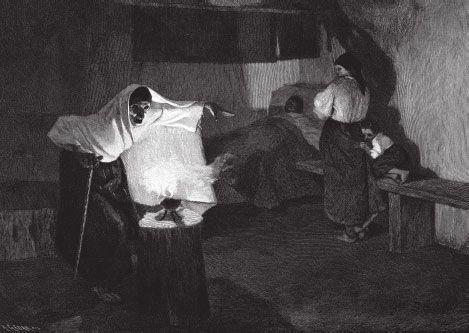Witchcraft Medicine: Healing Arts, Shamanic Practices, and Forbidden Plants (50 page)
Read Witchcraft Medicine: Healing Arts, Shamanic Practices, and Forbidden Plants Online
Authors: Claudia Müller-Ebeling,Christian Rätsch,Ph.D. Wolf-Dieter Storl

The toad
.
In the next section we will learn about a group of medicines that were known as “toad herbs.” In the first century C.E. Pliny had already reported on the poison from the gland secretions of the toad, and bestowed this amphibian with negative associations that easily awaken unpleasant feelings. The toad lives in the swampy morass, where humans feel insecure. In folk beliefs the toad, and its close relative the frog, plays a significant role.
27
In Christian iconography the toad is encountered as a symbolic animal of the devil, and it also represents transience and burdens. This negative complex is dramatically seen on the sculptures of Lord of the World and Lady World found on Gothic cathedrals. The sculptures offer the observer a seductive view, but when one looks behind the beautiful appearances one will see that toads and worms are gnawing on Lady World’s spine.
The dragon
.
With the dragon, various fear-inducing aspects are melded together to form a new hybrid: one that slithers like a snake, has the wings and claws of predatory birds, and shows the teeth-baring jaws of predatory animals. Such threatening primordial beings put heroes to the test, haunted saints, and forced themselves on innocent virgins. Dragons naturally appeared as the embodiment of terror and sin in many variations of images of the witches’ kitchen or the witches’ sabbat.
The billy-goat, ram, and ibex.
With their horned aggressiveness these animals embody masculine sensuality and potency, and they became in the Christian imagination the perfect example of the devil and the deadly sin of lust. In the countless and often drastic scenes of the horror of the Last Judgment, during which Satan pulls the damned from all social classes into his hellhole, the devil and his assistants are depicted with goat legs. Satan, who as an incubus with lecherous intentions visits women who are easily seduced, reveals his true nature on various woodcuts, on which he has horns that poke through his gallant hat or goat’s hips that jut out of his pants. During the witches’ sabbat the devil, in the shape of a black goat, plays a central role, and the witches demonstrate their respect by kissing him on his rear end. The Greeks, on the other hand, worshipped the goat-legged one as Pan, the flute-playing god of fertile nature.
The bat
.
The bat is a nocturnal animal that moves silently and orients itself in total darkness by ultrasound tones that are beyond the range of human senses. Thus, for seers and mystics the bat was a symbol of the receptivity of natural forces that usually remain hidden to humans. Although there are only a few bloodsucking bat species,
28
this harmless animal was connected to the idea of the vampire. In art the wings of this flying mammal—an animal that lives in caves—are used to symbolize a diabolic nature. In depictions of the witches’ sabbat and the witches’ kitchen, as well as in written accounts, bat’s blood has been repeatedly named as an ingredient of magical potions.
The cat
.
Cats have minds of their own. They are dependent only when they feel like being so, and they do not submit to the needs of humans. This has given cats the reputation of being “false.” As a rule, cats are loners. At night they hunt animals that humans find cute, such as birds and rabbits. With their whiskers, and their eyes that flash at night when a light hits them, cats have several keen senses at their disposal. In Germanic mythology the chariot of the love goddess, Freya, was pulled by cats—perhaps because they were the symbol of fertility.

The cat was a sacred animal to the Germanic love goddess, Freya. In the early modern era the goddess was demonized and turned into a witch, and the cat became a witch’s animal. Witches are said to transform themselves into cats in order to practice their sorcery. (Print illustration from Schmach, 1679.)
The bad-luck-bringing black cat remains the proverbial symbol of superstition. The fate of witches was tightly bound to that of cats, for often cats too were burned alive in order to destroy evil. Witches allegedly transformed themselves into cats. As late as 1850 the physician Leubscher wrote in his paper on the history of psychology that witches transform themselves into cats in order to creep up on children “to satisfy their vampiric desires.” The German word
Ketzer
(heretic) is said to derive from
Katze
(cat). And the term
Kathars
(Cathari, a sect with dualistic theology from the Middle Ages, the members of which were accused of being heretics), is said to come from
Kater
(tomcat). Satan, the lord of the cats, is depicted not only as a buck but also as a tomcat whose rear end the witches kiss on Walpurgis Night.
“Poison Mixers” and Healers
In 1930, when Wilhelm Fraenger, an art historian with an interest in folklore, contemplated the “terrible science of the herb-witch” in his description of the picture by the Petrarca master Hans Weiditz (see the illustration on page 151), he demonstrated how enduring the patterns of association established in the fifteenth and sixteenth centuries have proved to be. The activities he described are similar to those of the world of hell, and the science of the witch is “terrible” because of the bones, skulls, animal cadavers, and even small children that were seen strewn about in the witches’ environment or boiling in their cauldron. The imagination blended together such grisly set pieces and fashioned them into the props of a poison mixer, child murderess, and cannibal who was more likely to instigate bad weather than good or to mix black-magic potions than medicine.
“The thorny branches became entangled in a brewing turmoil. The plants that stand their heavy, jagged leaves on end, and that raise up their flower heads and grape-like umbels in the night, and the herbs that cover the ground in fertile lushness, reminds us of the terrible science of the herb-witch who sowed such plants, who brewed and dried them, and who knows how to extract magical drinks, elixirs, and medicine from them.”
—W
ILHELM
F
RAENGER
,
H
IERONYMUS
B
OSCH
,
1975
Surprisingly, whether the witch-women used their magical and healing knowledge to heal
or
to do damage was not so important to the Church. In 1975 Barbara Ehrenreich and Deidre English quoted an English witch hunter who must have really been fearful of these women:
For we must always keep in mind, that under witches we not only understand those who kill and torture, but all soothsayers, sorcerers, story-tellers, all magicians who are generally called wise men and wise women … and we also include all good witches, the ones who do not harm, but who do good deeds, the ones who don’t corrupt and destroy, but who save and protect. … It would be a thousand times better for this country if all witches, but in particular the charitable ones, were killed.
29
The Kartäus monk Johannes Hagen (c. 1415–1475) had a comparably healthier attitude toward witches. Hagen worked in Erfurt and gave himself the nickname Indaginis. Although he rejected—like almost all physicians of his time—the magical invocation of nature for the influencing of good and bad luck, he was, like the other doctors, at the same time convinced of the reality of demonic activities. But in the case of one woman he took a different position. The “witch of Blomberg” was a woman accused of desecrating the host in 1460. She admitted her deed under torture but pleaded her innocence at the execution place, whereupon a heavy hailstorm came down. This storm, which was interpreted as a heavenly indication of the woman’s guilt, was the reason they burned her. A decade later this incident still occupied the learned Kartäus monk. Hagen suggested that the bad weather had not necessarily been related to the witch and he accused the responsible clergy of possibly having the death of an innocent women on their shoulders.
In addition to the ruthless attitude of the English witch hunter quoted earlier, we shall consider an insightful, measured individual in order to paint a picture of the Church’s attitude toward the healing arts, which they believed to be aligned with the so-called witches. In more than five hundred preserved texts, Johannes Indaginis represents the views of the reform theology of his order on the topic of the healing arts. The following is from the edition edited by Klapper, who relays Indaginis’s writing in 1960.
Forbidden are all “blessings” for the healing of diseases, for those against the attack of wolves, against the gnawing worms, for healing wounds, for removing bullets, to stop blood from flowing. Herbs and stones are only to be used according to their natural powers. It is deadly sin and murder when women and old ladies kill the unborn in the mother’s womb with herbs, potions, or other methods.
Theologian Klapper sees Hagen in “the middle of a cultural process in which the bourgeois world was being released from concepts that still have their roots in pre-Christian concepts of folk wisdom.”
Around 1462 the monk Hagen turned with vigor against these traditional “alien teachings” when he judged (here I am following Klapper’s style) “magical things, magical treatments, conjurations, poisonous drinks, soothsaying, blessings, diabolic deceptions, witchery, divination, fortune-telling, seeing future events, day-choosing, sky gazing, solutions, pacts with the devil in the black arts, fortune telling with fire [and] earth, and other prognostications.”
30
These are all activities of the witches who had been accused of diabolic activity. Their enumeration demonstrates how fluid the borders between magic and medicine were in the fifteenth century and how effectively medicinal knowledge had been pushed into the realm of superstitions as merely a diverse accumulation of false and alien teachings. In a spiritual sense this battle should primarily be viewed in front of the backdrop of the Church’s exclusive claim on healing.
In contrast to our pragmatic times, in the fifteenth century medicinal and botanical knowledge was planted in the mystical spheres. According to the Church the
unio mystica,
the only connection to God permitted to the Christian, was—to use the allegorical terms of that era—via the mystical bride (personified by Mary) of God’s divine son. Mary is the one who conveys the knowledge of humans about a plant’s healing properties to the divine spheres and thereby integrates them in the divine order. She represents Ecclesias, the wisdom of the Church, and as such watches over the spiritual health of man. This ideology was recommended to all who willingly subordinated or were forced to subordinate to the dictates of the Church.

Three wise women in bourgeois dress approach a bedridden patient with pots of ointment. (Anonymous woodcut from
Compendium maleficarum,
Milan, 1626.)
The witch, however, turned to the plant spirit itself. She was consulted by people who wanted to receive healing for certain afflictions, because the witch herself turned to the wisdom of nature. The witch stands in the center of nature and incorporates the animals and plant ingredients into her brew, which she has found in nature. Accessing the hidden healing powers of nature directly, and not through the intermediary of the Church, was defamed as inadmissible magic and witchcraft. The woman who was vilified as a witch, and who usually lived apart from the Church people in nature, had physical recovery in mind and caused this healing with the help of plants. For this she must atone.

In dramatic shades of light and dark the elderly healer with her censer gives the impression of an old witch in the
Invocation for the Sick Person.
(S. Grocholski,
Krankenbeschwörung
, steel plate, end of the 19th century.)